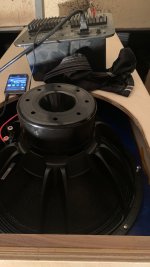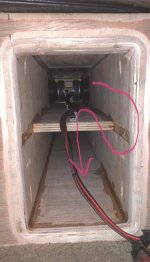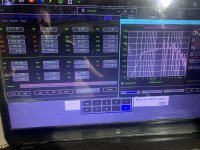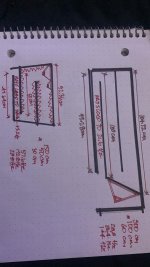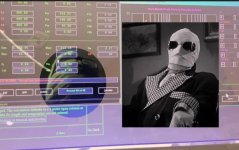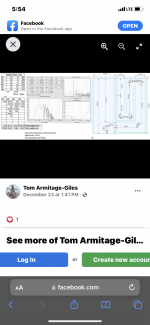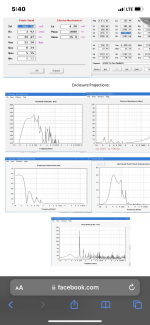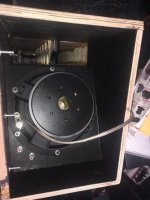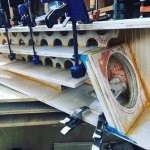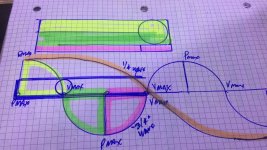The 18 ds115-4 version is on another level(obviously) . but all of us mere mortals would appreciate even the dayton Ultimax in an infrasonic version or a bunch of rss265, etc..in these or the ~1/2 Sd mass loaded versions (?) exit location gets intersting
Another application. of the same exact principles and the same intervals of harmonics used in closed end pipes and multiple qw resonators when perfectly aligned (seen in horn response as frequencies that show up completely canceled out as 0.0 phase or -990DB.). Intersting!!! Amazing.. fun!
Another application. of the same exact principles and the same intervals of harmonics used in closed end pipes and multiple qw resonators when perfectly aligned (seen in horn response as frequencies that show up completely canceled out as 0.0 phase or -990DB.). Intersting!!! Amazing.. fun!
Attachments
Last edited:
wondering when we use offset driver (at the first Pmin for the 3 x harmonic of the 1/4 used for Fb) entry with port exit and driver front output in same location vs this ^^ spaced out at a similar interval and with driver entry at/near Pmax for the fundamental instead ?? This design is 🔥🔥Not a realistic listening situation, nature of the unwanted HF coming out the terminus will have to have passed thru differeing number of high-pass filters.
In a horn with little or no damping the nature is important, in a TL with damping to kill the ripple not so much.

dave
This is an Air Cavity horn (conventional horn as opposed to Voigt horn), not a tapped horn. So no driver offest.
dave
dave
A revised version of the design. Here I've reconfigured it to use 0.5" ply for the sides and the internal panels. This increases the net volume of the box if the external dimensions are kept the same. I took the opportunity to decrease the size of the box a bit without giving up too much performance around Fb. This is beginning to look very buildable....




The 3:1 mass loaded (pi/9 ODMLTQwpipe) version is a beauty…. though suffering output levels by comparison to 33 hz @ 40 Vac and ~17 m/sec port velocity
Attachments
Last edited:
I can’t choose….?? Too many variety to use 😝 But When the driver output port doesn’t load the port…. It’s not a potent subwoofer layout for meThis is an Air Cavity horn (conventional horn as opposed to Voigt horn), not a tapped horn. So no driver offest.
dave
hey booger,The 3:1 mass loaded (pi/9 ODMLTQwpipe) version is a beauty…. though suffering output levels by comparison to 33 hz @ 40 Vac and ~17 m/sec port velocity
I was puzzled why your hornesp pics look washed out, just noticed you snapping pics of the laptop with your ....phone?
Most people use the built in win snap tool to select an area and digital capture the screen output.
However I prefer this tool called Lightshoot
https://app.prntscr.com/en/index.html
It is within my price range (freeee 😂 )
It remaps the prntscr key on your win machine
You can copy to the clipboard directly and paste over here.
It have some other functions but it is so handy
And easy to use.
You can save to a PNG if you want instead of copy to clipboard.
Anyway just wanted to share this win os app tool with you.
Love your high contrast screen theme
What you like to listen on Spotify 😁
Last edited:
Haa, the invisible man!You caught me !! 😝😝🙏🏻
thanks for the heads up, I’ll look into that.
spotify for everything on this devoted ’speaker’ laptop loaded with akabak, horn resp, rew, dsp from dayyton etc
I guess you are a REW guru also ⭐🌟✨
So prepare to be bothered when I start to take
Response measurments of a built sub 😇
Brian Steele is right to want to do-better than the standard quarter-wave TL. There's no magic there, just that a quarter-wave is an OK compromise for domestic music systems.
I'm very happy with my 17-foot labyrinth. A labyrinth is a TL without the fancy (and partly "speculative") theory leading to substantial effort in building to please the theory (which is partly "speculative" as I may have mentioned). I guess some folks feel more warm and secure if they have three-decimal-place expectations to cuddle with before building and I have no dispute with thinking-through a design as far as needed (as far as you can do with mental arithmetic on the back of an envelope) before ordering the Baltic Birch.
It is odd (to me) to see precisely detailed and elaborate theoretical designs applied to something as loosey-goosey as loudspeakers. Maybe good to have that kind of understanding beforehand IF you build a cab that can be tuned afterwards (which is not feasible with most TL designs, length of "long" wool aside).
If you really like a TL, try mocking up a cab that can be tuned.
https://www.diyaudio.com/forums/subwoofers/322418-17-foot-pipe-sub-12-230-hz-5db.html
I'm very happy with my 17-foot labyrinth. A labyrinth is a TL without the fancy (and partly "speculative") theory leading to substantial effort in building to please the theory (which is partly "speculative" as I may have mentioned). I guess some folks feel more warm and secure if they have three-decimal-place expectations to cuddle with before building and I have no dispute with thinking-through a design as far as needed (as far as you can do with mental arithmetic on the back of an envelope) before ordering the Baltic Birch.
It is odd (to me) to see precisely detailed and elaborate theoretical designs applied to something as loosey-goosey as loudspeakers. Maybe good to have that kind of understanding beforehand IF you build a cab that can be tuned afterwards (which is not feasible with most TL designs, length of "long" wool aside).
If you really like a TL, try mocking up a cab that can be tuned.
https://www.diyaudio.com/forums/subwoofers/322418-17-foot-pipe-sub-12-230-hz-5db.html
Last edited:
Yeah, did just fine doing rule-of-thumb (ROT) designs with only a measured Fs and even this isn't all that critical since stuffing density, room modes 'swamp' any LF speaker alignment, but many folks continue to believe that before T/S the pioneers were basically clueless since they don't even know/care that T/S is derived from all the 'physics of the situation' math the pioneers used.
Let me repeat GM's wise comment. The physics of all the familiar cabs haven't changed since even before some of us started in HiFi. T/S is a re-imagining of the parameters for clearer computation. Granted, there has been lots of R&D since, even slight adjustments to T/S like with flexible inductance.
Now I join GM is praising the pioneers... and not just because I bought my first equipment before the World Trade Center construction displaced the hifi district in NYC in 1957.
Now I join GM is praising the pioneers... and not just because I bought my first equipment before the World Trade Center construction displaced the hifi district in NYC in 1957.
Wavelengths and odd numbered harmonics never change (except in proportion to temperature…) ..
CSA is dialed in for ‘TS parameters.
But Stuffing (damping this all appropriatel) is GOD😝 never was it so apparent that a stuffed pipe was the real answer until it was right in front of me in a variety of ways to compare/contrast (3:1 parallel to a series exit, or 1/3 ODMLTL are the bees kneez….
but Anything that’s slightly off/misaligned in that cheat to grab onto that other resonator at the next harmonic is BAD (worse then it might sim a little scratch or scar however)
CSA is dialed in for ‘TS parameters.
But Stuffing (damping this all appropriatel) is GOD😝 never was it so apparent that a stuffed pipe was the real answer until it was right in front of me in a variety of ways to compare/contrast (3:1 parallel to a series exit, or 1/3 ODMLTL are the bees kneez….
but Anything that’s slightly off/misaligned in that cheat to grab onto that other resonator at the next harmonic is BAD (worse then it might sim a little scratch or scar however)
Last edited by a moderator:
accidentally getting further from precisely 3/1 in parallelqw pipes to same exit, or (pi/9~ 1/3 ) in ODTL version closer to the even numbered areas (that don’t exist in closed end pipes) is BAD bad bad. risky game of pipe gambling for ‘more’ from nothing essentially.
that hiccup is the devil 🔥 and is misaligned to a red flag that should concern anyone(measured and simmmed agree)
I always listen when GM mentions damping!!! It’s the ultimate tool for a variety of reasons 👍🏼👍🏼
that hiccup is the devil 🔥 and is misaligned to a red flag that should concern anyone(measured and simmmed agree)
I always listen when GM mentions damping!!! It’s the ultimate tool for a variety of reasons 👍🏼👍🏼
Attachments
Last edited by a moderator:
Use it or ignore it , but it’s FAR from ‘mediocre’. It’s not just the 3 x 1/4 harmonic .. it’s the strategic implement of LP filters at node/antinode and easy to build architecture that supports the fundamental instead of chopping it up into random whatever snake (oil) geometries that are reluctant to sim correctly in a taper or flare dilution /pollution or not just be ‘a big long random casserole of awkwardly spaced and shaped ’ resonators’ to a vent ‘ ? that ‘sorta’ works…??😱
it’s all junk if you just wanna el pipeoh your way thru it instead , but el pipe oh isnt the ‘exclusive’ answer, in fact it’s just the beginning If increasingly exciting and wonderful things once aligned appropriately instead of not
it’s all junk if you just wanna el pipeoh your way thru it instead , but el pipe oh isnt the ‘exclusive’ answer, in fact it’s just the beginning If increasingly exciting and wonderful things once aligned appropriately instead of not
Attachments
Last edited:
You guys kill me, LOL.
All the "classical TL" theory was shown to be basically rubbish (e.g. wool stuffing does NOT "slow down" sound waves anywhere near what was preached by the classical theory). I know, because I used to have the classical theory approach outlined on my website on my TL page .... until I read Martin King's work on the subject and realised that it was all sonorous nonsense.
Here's what happens when you follow that classical theory - you end up building the equivalent of a "bass whistle", and the only way to stop it droning on at Fb is stuff most of the enclosure - which makes it very lossy and reduces the "Q" of the resonance at Fb until its acceptable. The end result is that you end up with a much larger box than required to achieve a particular Fb and F3 than what could be achieved using modern theory based around t/s parameters. And there's nothing "speculative" about it. Both of my TL builds (the "Boom Unit" and POC6) measured almost exactly as predicted by Hornresp, requiring no "trial and error" on my part to get them to meet my goals.
All the "classical TL" theory was shown to be basically rubbish (e.g. wool stuffing does NOT "slow down" sound waves anywhere near what was preached by the classical theory). I know, because I used to have the classical theory approach outlined on my website on my TL page .... until I read Martin King's work on the subject and realised that it was all sonorous nonsense.
Here's what happens when you follow that classical theory - you end up building the equivalent of a "bass whistle", and the only way to stop it droning on at Fb is stuff most of the enclosure - which makes it very lossy and reduces the "Q" of the resonance at Fb until its acceptable. The end result is that you end up with a much larger box than required to achieve a particular Fb and F3 than what could be achieved using modern theory based around t/s parameters. And there's nothing "speculative" about it. Both of my TL builds (the "Boom Unit" and POC6) measured almost exactly as predicted by Hornresp, requiring no "trial and error" on my part to get them to meet my goals.
All the "classical TL" theory was shown to be basically rubbish
:^)
dave
Would You rather have the 40 hz qwpipe flat at ~120dB over -2/3 dB at 32 hz MLqwpipe instead? I don’t think either exceed 17m/sec @ 40 volts input or xmax innthe simsYou guys kill me, LOL.
All the "classical TL" theory was shown to be basically rubbish (e.g. wool stuffing does NOT "slow down" sound waves anywhere near what was preached by the classical theory). I know, because I used to have the classical theory approach outlined on my website on my TL page .... until I read Martin King's work on the subject and realised that it was all sonorous nonsense.
Here's what happens when you follow that classical theory - you end up building the equivalent of a "bass whistle", and the only way to stop it droning on at Fb is stuff most of the enclosure - which makes it very lossy and reduces the "Q" of the resonance at Fb until its acceptable. The end result is that you end up with a much larger box than required to achieve a particular Fb and F3 than what could be achieved using modern theory based around t/s parameters. And there's nothing "speculative" about it. Both of my TL builds (the "Boom Unit" and POC6) measured almost exactly as predicted by Hornresp, requiring no "trial and error" on my part to get them to meet my goals.
Last edited:
Can you please describe the way you did your measurements. If tested indoors, how did you erase the influence of room acoustics?...and there's nothing "speculative" about it. Both of my TL builds (the "Boom Unit" and POC6) measured almost exactly as predicted by Hornresp, requiring no "trial and error" on my part to get them to meet my goals.
B.
- Home
- Loudspeakers
- Subwoofers
- Big, big TL...
